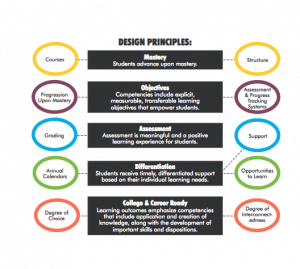Design Thinking
CompetencyWorks Blog
 I think about design a lot. I can’t help it when two siblings are designers (transportation and landscape). It’s the common language of our family.
I think about design a lot. I can’t help it when two siblings are designers (transportation and landscape). It’s the common language of our family.
Design thinking is definitely making it’s way into the world of education. I love this 2Revs video where Design is the third way between Dreaming and Dreading. Many of the new design principles that are being developed to guide school development include reference to mastery-based or competency-based approaches. (Note: We aren’t seeing as much discussion about redesigning districts yet – I’m sure we’ll get there soon).
There is much more transparency about design principles and much stronger emphasis on co-design than we’ve seen in the past. It’s really helpful when you can see the values or principles that are driving a company up front – 2Revolutions put their design principles out front. So does the Kentucky P20 Innovation Lab based at the College of Education, University of Kentucky (they are partners in CCSSO’s Innovation Lab Network). Wouldn’t it be interesting to see how a traditional district or school would describe their design principles?
Summer time is planning time for educators…so I thought I’d put together a few of the school design resources for you:
- A new resource is the RETHINK: Planning and Designing for K-12 Next Generation Learning tool kit produced by Next Generation Learning Challenges (NGLC) and the International Association for K-12 Online Learning (iNACOL) for K-12 district, charter, and school leaders to use in the very early stages of conceptualizing and designing a next generation learning program, initiative, or whole school.
- Carnegie Corporation outlines their design principles for their emerging initiative to support states and districts in creating innovative schools in their report Opportunity by Design. There is a set of 10 principles including an emphasis on mastery. Carnegie is also launching a new organization, Springpoint, led by JoEllen Lynch ( a member of the CompetencyWorks Advisory) to catalyze the initiative.
- Digital Learning Now’s The Shift from Cohorts to Competency by Tom Vander Ark, Carrie Schneider, John Bailey, and yours truly dives into 10 of the design choices innovators are using to support competency education.
- If design thinking is totally new to you take a peek at some of the toolkits from IDEO. They have a Human-Centered Design Tool Kit (think student-centered) and a Design Kit for Educators. I can’t help but think that students would love to develop expertise in design!
Design is only one piece of the puzzle for districts and schools that are converting to competency education. The transition process is much more challenging than making the design choices. There are only a few strong technical assistance providers that are able to share their knowledge on how to engage educators and the broader community in believing that competency education is the right direction to go. It’s a weakness in our field…I’m hoping that our philanthropy partners are having the discussions to address this problem. We have to figure out how to use other techniques to support the transfer of knowledge – online courses, video’s, peer coaching…other ideas?
If you are going to iNACOL’s Blended and Online Symposium in October, we’ll be gathering at a pre-conference workshop to talk about the different design choices that schools are making to reinforce competency education. Let me know if you are planning on attending…so we can make sure that we highlight your school design in the discussion.
